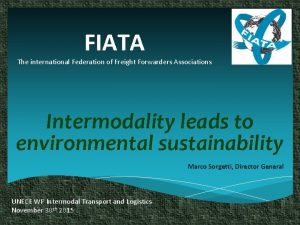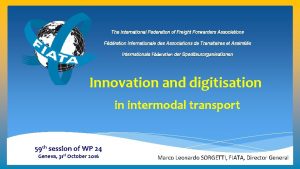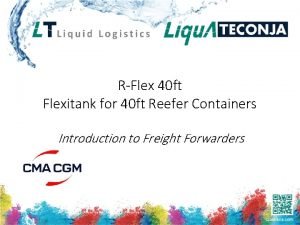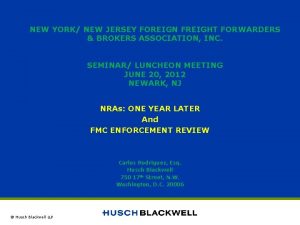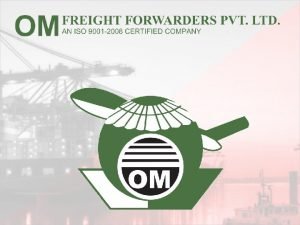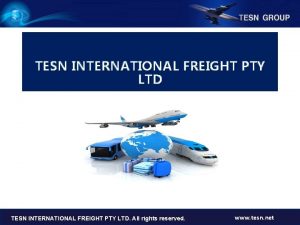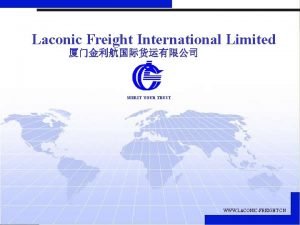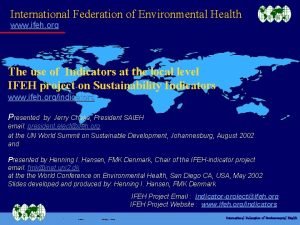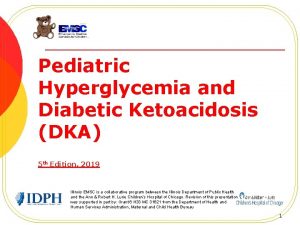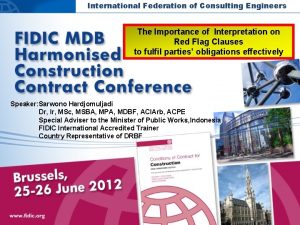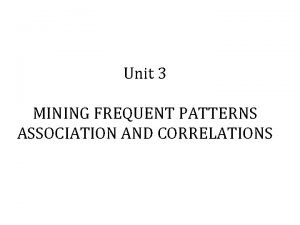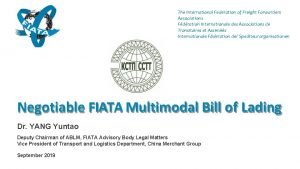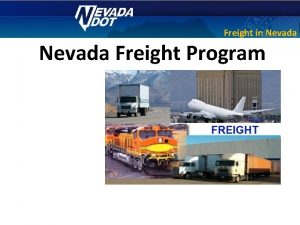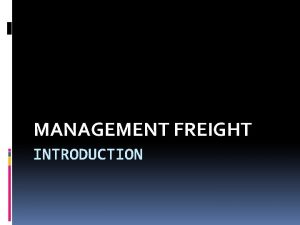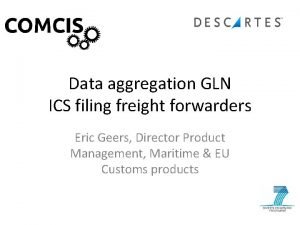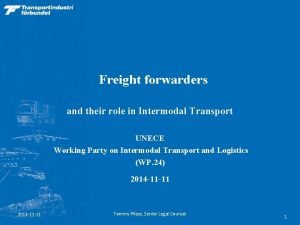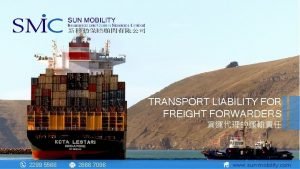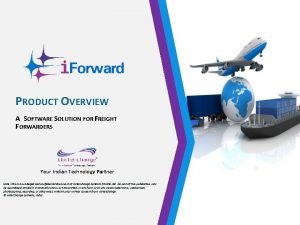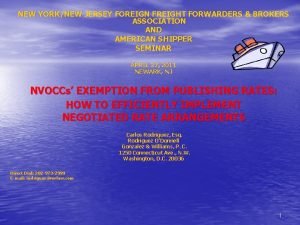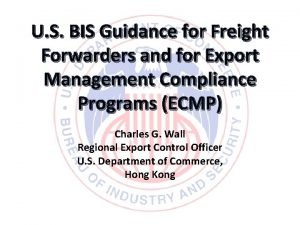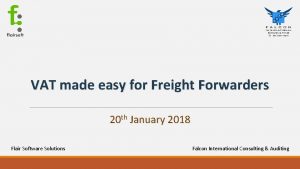The International Federation of Freight Forwarders Associations Fdration















- Slides: 15

The International Federation of Freight Forwarders Associations Fédération Internationale des Associations de Transitaires et Assimilés Internationale Föderation der Spediteurorganisationen Innovation and digitisation in intermodal transport 59 th session of WP 24 Geneva, 31 st October 2016 Marco Leonardo SORGETTI, FIATA, Director General

FIATA 90 th anniversary in Dublin FIATA was founded on 31 th May 1926 in Vienna. FIATA is the largest non-governmental organisation in the field of transportation. Its influence is worldwide. FIATA has consultative status with UN/ECOSOC, ESCWA, UNECE, UNESCAP, UNCTAD, UNCITRAL, UNDP etc. FIATA is the recognised representative body of the freight forwarding and logistics industry for intergovernmental organisations such as ICAO, ITF, OECD, WCO, WTO, World Bank, etc. & private sector, e. g. GSF, IATA, ICC, IRU, UIC, etc.

FIATA’s Global, Unique Constituency • 108 Association Members in 98 countries • 5600 direct Individual Members in 160 countries • Largest world wide NGO in Transport and Logistics

Innovating logistics with a plan Institutes, Advisory Bodies, Working Groups WG Incoterms Airfreight Institute AFI Customs Affairs Insitute CAI Advisory Body Safety Security Multimodal Transport Institute MTI Advisory Body Vocational Training WG Rail WG Road FIATA Logistics Academy WG Sea Advisory Body Information Technology Advisory Body International Affairs WG Sustainable Logistics

End to End Value Chains are Changing Freight Forwarders are common users of multimodal solutions from pick up to delivery, working with carriers, using all transport modes and providing trade facilitation International Trade and Commerce is rapidly changing: “more than half of our customers today did not exist ten years ago” Disrupting elements come into play: drone deliveries, 3 D printing, more parcels than crates, less efficient packing – sustainability not always in sight speed and efficiency appear to be at either end of SUSTAINABILITY …. Or not?

FWC 2016 Dublin Chronicle Speed and efficiency at either end of sustainability “half of our customers today did not exist ten years ago”

EU: stable (? ) share of modes

Intermodal Challenges & Opportunity Share from Sea and Road Transport to Rail New transcontinental Rail Freight Corridors FIATA and UIC met European and Asian operators in Shenzhen in 2016 Mo. U with OSJD and Chinese experts in the FIATA WG Rail Harmonisation of standards Digitising Transport Documents – e. CMR, FIATA e-FBL, DTLF’s mapping exercise…. UNCEFACT, a Ferrari in the garage? Infrastructure Equality Initiatives Connecting Europe Facility, ASEAN intermodal initiatives, One Road One Belt, African corridors and Trade facilitation Environmental rules put pressure on transport UNFCCC Agreement encourage states to curb freight emissions and promote intermodal solutions

Sitting on the Dock, looking at the (e)Bay Majority of containers in Europe arriving to North Sea ports Average port hinterland leg only between 10 - 20% of containers by rail long and expensive deliveries Trend: ship’s dimensions in light of sustainable, efficient services Trend: geography vs. costs, is there a balance? Inland ports – some grow at 5% per annum, is it just business model? Innovation on the high seas, greener ships, ports, slow steaming, 20000+ TEU’s – is there a breakthrough customers will want to buy? IATA/FIATA principal to principal agreement, surely not a pie in the sky, but a lot of work to do as implementation starts.

Strong Sustainability Focus Greenhouse gas (GHG) emissions on the rise >>>>> FIATA’s Public Statement Source http: //www. noaa. gov/ Asks policy makers to not only focus on enacting legislation that will set GHG emissions targets BUT also to enact policy that would enable enhanced connectivity and efficient transport operations which will lead to lower GHG emissions SMARTER INFRASTRUCTURE FOR SMARTER, MORE SUSTAINABLE SOLUTIONS Environment: Key Aspect in Every CONTEMPORARY Logistics Project

Sluggish Technology Adoption Uptake of recent ICT advances for multimodal – So Slow, Why? Fragmented Industry, with real issues Financial and resource constraints to adopting ICT, uncertainty of results and mistrust of the new Authorities prudent in mandating rules they struggle to implement due to insufficient resources Human Capital Lack of ICT Specialists entering the field of logistics Vocational and life-long learning struggling to keep pace with technology changes Varying ICT Applications based on Mode Interconnectivity between different applications a barrier Interoperability still in wish-list phase Insufficient harmonisation of standards

Opportunities in Technology Cloud Computing & big data ICT systems can be hosted by a third party and logistics companies can just “plug in and play” for Saa. S solutions Tailored for SME lacking of resources to host own system, but TMS’s are trying to reach out – in Dublin 2/3 of exhibitors were technology related Internet of Things, driverless vehicles, smart, connected infrastructure may come to assist with new solutions, as many LSP’s maintain research centres and re-engineer the last mile delivery Web 3. 0 and social networking could be applied to enable the optimisation of the distribution flow of cargo

FIATA’s at Work FIATA e-FBL FIATA’s e-FBL Promoting the digitization of documents and standardization across Europe to help enhance seamless shifts between modes WG Sustainable Logistics Positions asking States to push for a standard calculation method for measuring carbon footprint Participating in UNECE’s Euro-Asian Transport Links (EATL) project removing physical and administrative bottlenecks Unifying railway law DTLF at EU level Local association members (PK, CN) engaged in e. TIR and e. CMR

FIATA’s conclusions Trade patterns are changing at increased speed ICT Standards are challenged by new technology but both are required to provide innovative services, legacy systems will not go away in months and probably not even in years FIATA has structure in place to assist and lead the way, but need cooperation with all stakeholders, principally with shippers on the one hand regulators on the other There’s no business like logistics…. or without it!

Work with us, please! www. fiata. com Thank you!
 International federation of freight forwarders associations
International federation of freight forwarders associations International federation of freight forwarders associations
International federation of freight forwarders associations Liqua flexitank
Liqua flexitank Ny nj foreign freight forwarders
Ny nj foreign freight forwarders Om freight forwarders
Om freight forwarders Tesn international freight pty ltd
Tesn international freight pty ltd Laconic freight international ltd
Laconic freight international ltd International federation of environmental health
International federation of environmental health International diabetes federation
International diabetes federation Occurenced
Occurenced International federation of pharmaceutical manufacturers
International federation of pharmaceutical manufacturers International federation of nurse anesthetists
International federation of nurse anesthetists Interreligious and international federation for world peace
Interreligious and international federation for world peace Schizophrenia
Schizophrenia Mining frequent patterns associations and correlations
Mining frequent patterns associations and correlations Mental status examination purpose
Mental status examination purpose
